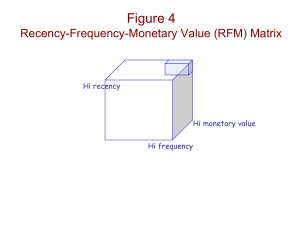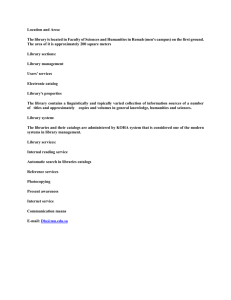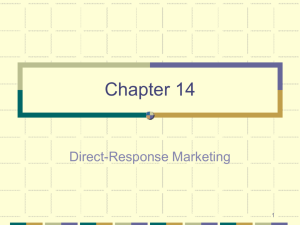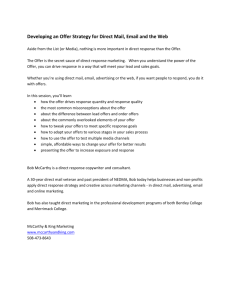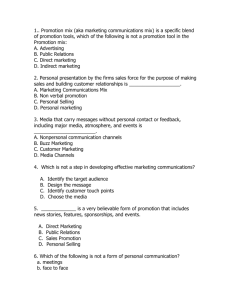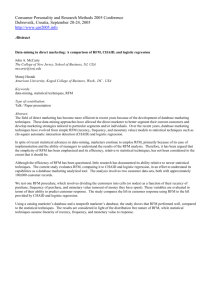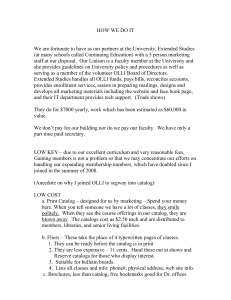Direct Marketing - University of Washington
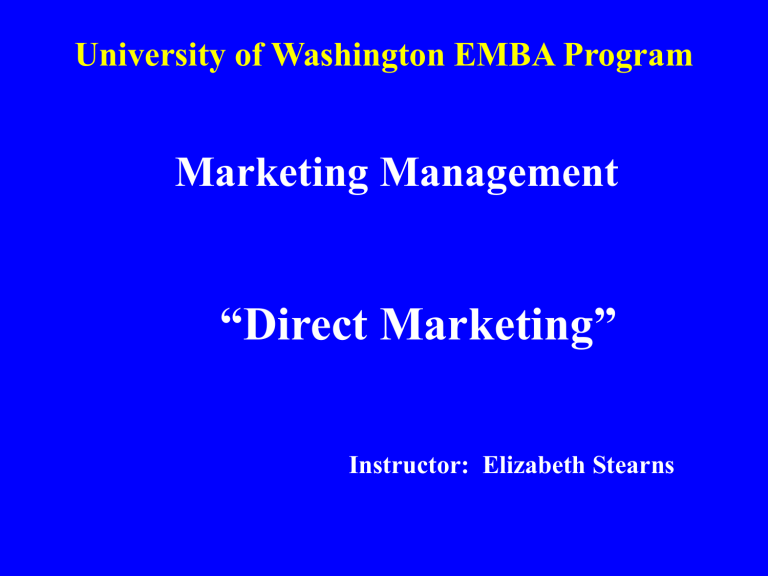
University of Washington EMBA Program
Marketing Management
“Direct Marketing”
Instructor: Elizabeth Stearns
Marketing Plan Review
Analysis of promotional program situation
Analysis of the communication process
Budget Determination
Develop integrated marketing communications program
Advertising Direct Marketing
Sales Promotion
PR/ Publicity Personal Selling
•
Create Awareness
•
Develop Attitudes
•
Change Attitudes
•
Inform
•
Persuade
•
Generate a Sale
•
Generate a Lead
•
Qualify a Lead
•
Enhance a db
•
Relationship
Building
•
Create Excitement
•
Stimulate demand/sales(short term)
•
Support sales force/trade/customer
(selling and buying)
•
Fostering
Goodwill between co. and publics
•
Brand Awareness
•
Build Attitudes
•
Encourage purchase behavior
•
Influence purchase needs
•
Educate consumers
•
Provide
Product usage/marketing assistance/
•
After sale service and support
Communications Stream/Response
How Customers Respond
Person Mail Phone Fax email Web
Person
Phone
Fax email
Web
TV
Radio
Outdoors
POS
Wireless
Dr. Gary Bridge, IBM
INTRODUCTION
Direct Marketing
• An organized and planned system of contacts
• Using a variety of media
• Supported by general advertising in print and broadcast media, if appropriate
• Aimed at selected prospects and customers
Direct Marketing
• Seeking to produce a lead or an order
• Measurable in its costs and results
• Improvable through testing and analysis
• Expandable with confidence
Functions of Direct Marketing
• Make a sale
• Generate a lead
• Qualify a lead
• Relationship building
• Database enhancing
Definition of Direct Marketing
• “Direct marketing is an interactive system of marketing which uses one or more advertising media to effect a measurable response and/or transaction at any location”
Direct Marketing Update 2000
• Total Sales Revenue:
Catalogue
Internet
US$ 1.7 trillion
US$ 110.6 billion
US$ 24.2 billion
• Jobs:
• DR Advertising :
Mail alone
Source: WEFA/DMA
15.6 million
11.6 % US Employment
US$ 191.6 billion
(56.5% total adv. $)
US $33 billion
Image Response
• Connectivity between all communications
• Maximizing budgets
• Not distruptive of other efforts
Available Media
• Brochures or catalogs sent by mail
• Radio and TV ads
• Television Shopping Networks/Programs
• Telephone
• Newspaper and magazine ads, preprints, bind-ins, etc.
• Statement inserts
• Cooperative mailings
Available Media
• Package and bag stuffers
• Take-ones
• Cereal boxes, egg and milk cartons, matchbooks, etc.
• Interactive cable
• Worldwide Web/Internet
The Role of Media
• Media planning is concerned with how to use advertising time and space most effectively (and efficiently) to contribute to the achievement of marketing objectives.
The Role of Media
• Media provides a bridge that delivers the right message (and offer) to the right target. In this respect, media decisions that deliver both image/awareness are the same for direct response efforts.
• Media planning that is involved with generating a direct response, goes steps further in analyzing previous results and projecting future response.
Media’s Role in Direct Marketing
• The “accountable” nature of direct marketing is the crucial determining factor used to plan each media campaign.
Historical response analysis is the foundation and starting point for the overall planning process.
Media’s Role in Direct Marketing
• Front-end Response
-% response
-Orders per thousand
-Cost per order
Media’s Role in Direct Marketing
• Back-end Response
-The quality of the customer is primarily measured by total sales (net of bad pay) per customer, but related measures are also used such as: conversion %, renewal rate and upgrade %, cross promotion sales, credit card usage, and ultimately a
“Lifetime Customer Value” Index.
The Planning Process
• Historical response analysis* is the foundation for the planning process:
–Front end response
•% response and cost per inquiry
–Back end response
•% quality of customer and lifetime value
Managing the Buy
Objectives are managed over the length of the campaign
• Counts are received from the telemarketing services on a daily basis.
• Exact times are received from the stations.
• Buyers adjust schedules daily based upon performance and availability of air time.
Managing the Buy
Responsiveness on a daily basis
• Rates are renegotiated.
• “No-charges” are negotiated.
• Ineffective/inefficient dayparts are eliminated.
• Spending is increased on well-performing stations.
• Poor stations are eliminated.
• New stations are recommended.
Managing the Buy
As a result...
• Flight dates are shortened or extended.
• Alternate commercial lengths are tested and used.
• Creative/product fatigue is assessed.
• Individual station activity is added to, reduced, or cancelled.
Type of Lists
• Compiled
– Names and addresses derived from directories, public records, newspapers, retail sales slips, trade show registrants, etc., to identify groups of people who have something (single identifiable characteristic) in common.
Type of Lists
• Response
– Names and addresses of consumers or business executives who ordered and paid for a product or service through the mail.
• Response Enhanced
– Consumers(purchasers) who have filled out questionnaires and mailed in those questionnaires which describe their demographics, psychographics and specific product buying habits.
• House List
– Purchased or inquired, 5-6 times better results
Development of DM in U.S.
• Substantial mail order activity in existence for more than
100 years
• Originally built to serve needs of a working class, rural nation
• In 20th century specialty businesses evolved
– Often featured low price but hard-to-find items
– Fostered a “discount” image
– Market mostly middle/lower class
– Pattern of thousands of small, independent mail order businesses established
1950
Development of DM in U.S. (cont.)
• Starting in 60’s patterns changed markedly
– Rapid growth; faster than retail
– Achieved “in” status, better public image
– Quality, variety, convenience became main reasons for purchase, not prices
– Market became urban/suburban, upper middle class
Development of DM in U.S. (cont.)
– Rapid growth in number of, and access to, rented lists of mail order buyers
– Large companies saw growth opportunitiesbought/started direct marketing activities
– Still thousands of companies, few with sales of more than $100 million
Development of DM in U.S. (cont.)
• Late 80’s/90’s saw:
– Slower growth of consumer businesses
– Time Poor Consumers: “Cognitive Overload”
– Growth of multi-channel-particularly addition of retail stores by mail order businesses-much faster than serious growth of direct marketing by retail
Development of DM in U.S. (cont.)
– Internet growth for ecommerce
– Continued use of database by financial, transportation, manufacturing sectors
– Relational vs. Transactional databases
– Technology as a facilitator and inhibitor (Privacy)
Development of DM in US (cont.)
• 21st Century
– Real time customer
– Mandatory multi channel-customer choice
– Privacy needs/remedies confused,-self regulation and gov’t involved
– Fulfillment & database essential skill setsoften not resident at ecommerce companies
– CRM: hot topic! Myth or Reality
Using technology to understand your customer
“Hug Me”
Your customers will shop and purchase as is convenient/appropriate for them (hint: not you!)
Set up your systems to capture behavior to get a complete look at your customer.
Development of DM in U.S. (cont.)
• Business to business sector has grown rapidly, now about 50% of total sales. Efficient as:
– Prospecting tool
– Way to sell low volume customers or low volume product
– Information/intelligence gatherer
– Sales!
Trends Favorable to Growth
Demographic and Lifestyles
• For households in which both adults work and for business customers, convenience and time savings assume great importance.
– Many U.S. consumers have more discretionary money than time.
– Or when they are managing to less discretionary money, info and choices are readily available through multiple DM means.
– Businesses are seeking higher productivity.
• Higher educational levels – particularly with the “baby boom” generation - produce more shoppers with selfconfidence to permit purchase decisions based on written materials.
Trends Favorable to Growth
Demographic and Lifestyles (cont.)
• Retail shopping less often provides an enriching or self-gratifying experience.
• Individual consumer’s values/needs can be recognized in personalized or interactive direct marketing communications that replace the physical one to one contact that is no longer affordable.
Trends Favorable to Growth
Marketing Needs of Major Corporations
• Rising costs of marketing and declining price or many products, requires greater efficiency.
• Narrow/specialized target markets must be dealt with individually.
Trends Favorable to Growth
Marketing Needs of Major Corporations
• Multiple distribution channels are required. Direct marketing, as one, is both complementary and incremental.
• Direct marketing databases and discipline assist measurement of other channels and of conventional advertising.
R-F-M
• Recency
– When was the last time they purchased?
• Frequency
– How often do they purchase?
• Monetary Value
– How much money do they spend?
RFM Definition
RFM is a behavioral segmentation technique
• Typically used to select likely profitable customers to receive direct marketing treatment
• It postulates that the most likely prospects are recent purchasers who have historically demonstrated more frequent than average purchase behavior in larger than average dollar amounts
• It is based on a correlation between RFM and response
• Historically it has proven to be an effective segmentation technique for many situations
• The variables RFM are frequently influential in many advanced statistical modeling techniques
RFM Definition (cont’d)
• The variables must be interpreted within the context of product purchase dynamics
– Durable
– Consumables
– Periodic
• Can be used to manage marketing investment by selecting target customers
• Can also be used to improve marketing performance by managing message/offer components
RFM Elements
Segmentation
Concept
Behavioral
Question
Data Element/
Measurement
Recency When did they last buy?
Date of last purchase
Frequency How often do they buy?
# of purchases over time
Monetary
Value
How much do they spend?
$ value of purchases
Process:
•Sort by date
•Create groups by date range
Options:
Within recency group, months on file, # times mailed
Options:
Within recency group, months on file, # times mailed
RFM / Customer Treatment
RFM segmentation can be used to manage customer treatment across functions
Functional Dimension
Customer Service
Billing
Collections
Credit
Marketing
Treatment Implication
Service Level
Adjustment Practices
Minor delinquency action
Over limit action
Incentives/Premiums
Sensitivity Analysis
• Three variables are often used to develop a picture that gives a range of possibilities to achieve financial objectives:
– Response Rate (and the cost to achieve this)
– Average Order Size (and requisite merchandise)
– Circulation/Audience Size (and economies for volume)
• These are reviewed to give a reality check on Best/Worst/Most
Likely scenaria, and provide a good basis for a monthly Cash Flow analysis.
Ruth Owades Sensitivity Analysis
Assumptions
Gross margin
Fulfillment and O.H.
Inventory Writedown
Catalog Expense
Mailing Size
Average Order Size
Response Rates
Sales
Gross Margin
Catalog Expense
Fulfillment and Overhead
Writedown of Inventory
Contribution
55%
15%
4%
=$50K+$25K/200K catalogs
100,000 200,000
30
1.4%
$ 42.0
$ 23.1
$
$
30
1.4%
84.0
46.2
$ 62.5
$ 6.3
$ 1.7
$ (47.4)
$ 75.0
$ 12.6
$ 3.4
$ (44.8)
400,000
30
1.4%
$ 168.0
$ 92.4
$ 100.0
$ 25.2
$ 6.7
$ (39.5)
600,000
30
1.4%
$ 252.0
$ 138.6
$ 125.0
$ 37.8
$ 10.1
$ (34.3)
800,000
30
1.4%
$ 336.0
$ 184.8
$ 150.0
$ 50.4
$ 13.4
$ (29.0)
Response Rate
4.0%
4.5%
15.20
29.60
44.00
62.00
400,000 Catalogs Mailed
Average Order Size
$ (39.5)
1.0%
1.5%
2.0%
2.5%
3.0%
3.5%
20
(71.20)
(56.80)
(42.40)
(28.00)
(13.60)
0.80
25
(64.00)
(46.00)
(28.00)
(10.00)
8.00
26.00
30
(56.80)
(35.20)
(13.60)
8.00
29.60
51.20
72.80
94.40
35
(49.60)
(24.40)
0.80
26.00
51.20
76.40
101.60
126.80
40
(42.40)
(13.60)
15.20
44.00
72.80
101.60
130.40
159.20
Response Rate
Average Order Size
$ (47.4) 20 25
100,000 Catalogs Mailed
30 35
1.0%
1.5%
2.0%
2.5%
3.0%
3.5%
4.0%
4.5%
(55.30)
(51.70)
(48.10)
(44.50)
(40.90)
(37.30)
(33.70)
(30.10)
(53.50)
(49.00)
(44.50)
(40.00)
(35.50)
(31.00)
(26.50)
(22.00)
(51.70)
(46.30)
(40.90)
(35.50)
(30.10)
(24.70)
(19.30)
(13.90)
(49.90)
(43.60)
(37.30)
(31.00)
(24.70)
(18.40)
(12.10)
(5.80)
40
(48.10)
(40.90)
(33.70)
(26.50)
(19.30)
(12.10)
(4.90)
2.30
45
(46.30)
(38.20)
(30.10)
(22.00)
(13.90)
(5.80)
2.30
10.40
50
(44.50)
(35.50)
(26.50)
(17.50)
(8.50)
0.50
9.50
18.50
Response Rate
600,000 Catalogs Mailed
Average Order Size
$ (34.3)
1.0%
1.5%
20
(81.80)
(60.20)
25
(71.00)
(44.00)
30
(60.20)
(27.80)
35
(49.40)
(11.60)
2.0%
2.5%
3.0%
3.5%
4.0%
4.5%
(38.60)
(17.00)
4.60
26.20
47.80
69.40
(17.00)
10.00
37.00
64.00
91.00
118.00
4.60
37.00
69.40
101.80
134.20
166.60
26.20
64.00
101.80
139.60
177.40
215.20
40
(38.60)
4.60
47.80
91.00
134.20
177.40
220.60
263.80
Response Rate
Average Order Size
$ (44.8)
1.0%
20
(60.60)
25
(57.00)
200,000 Catalogs Mailed
30
(53.40)
35
(49.80)
1.5%
2.0%
2.5%
3.0%
3.5%
4.0%
4.5%
(53.40)
(46.20)
(39.00)
(31.80)
(24.60)
(17.40)
(10.20)
(48.00)
(39.00)
(30.00)
(21.00)
(12.00)
(3.00)
6.00
(42.60)
(31.80)
(21.00)
(10.20)
0.60
11.40
22.20
(37.20)
(24.60)
(12.00)
0.60
13.20
25.80
38.40
40
(46.20)
(31.80)
(17.40)
(3.00)
11.40
25.80
40.20
54.60
45
(42.60)
(26.40)
(10.20)
6.00
22.20
38.40
54.60
70.80
50
(39.00)
(21.00)
(3.00)
15.00
33.00
51.00
69.00
87.00
Response Rate
4.0%
4.5%
80.40
109.20
138.00
174.00
800,000 Catalogs Mailed
Average Order Size
$ (29.0)
1.0%
1.5%
2.0%
2.5%
3.0%
3.5%
20
(92.40)
(63.60)
(34.80)
(6.00)
22.80
51.60
25
(78.00)
(42.00)
(6.00)
30.00
66.00
102.00
30
(63.60)
(20.40)
22.80
66.00
109.20
152.40
195.60
238.80
35
(49.20)
1.20
51.60
102.00
152.40
202.80
253.20
303.60
40
(34.80)
22.80
80.40
138.00
195.60
253.20
310.80
368.40
45
(35.20)
(2.80)
29.60
62.00
94.40
126.80
159.20
191.60
50
(28.00)
8.00
44.00
80.00
116.00
152.00
188.00
224.00
45
(27.80)
20.80
69.40
118.00
166.60
215.20
263.80
312.40
45
(20.40)
44.40
109.20
174.00
238.80
303.60
368.40
433.20
50
(17.00)
37.00
91.00
145.00
199.00
253.00
307.00
361.00
50
(6.00)
66.00
138.00
210.00
282.00
354.00
426.00
498.00
Gains Chart for Responsiveness
6
7
8
9
10
3
4
5
1
2
Decile Qty.
Mailed
(000)
600
1,200
1,800
2,400
3,000
3,600
4,200
4,800
5,400
6,000
Number
Resp. (#)
Percent
Resp.
(%)
20,250 3.37%
34,200 2.85
48,330
60,840
67,500
2.68
2.53
2.25
76,680
81,900
84,960
87,480
90,000
2.13
1.95
1.77
1.62
1.50
Mailing Cost: $400/thousand
*Index of Relative Responsiveness; Universe Indexed to 100.
Source: Direct Marketing, November 1988
Resp.
Gain
Index*
225
190
179
169
150
142
130
118
108
100
Revenue
Generated
(000)
$506
855
1,208
1,521
1,687
1,917
2,047
2,124
2,187
2,250
Revenue: $25/response
Mailing
Cost
(000)
$240
480
720
960
1,200
1,440
1,680
1,920
2,160
2,400
Total
Profit
(000)
$266
375
488
561
487
477
367
204
27
-150
Customer Data
Customer
Characteristics
•Demographics
•Psychographics
•Household Composition
Marketing Management
Information
Contact History
Behavior
Change Drivers
Key Behavior
Events
Performance Metrics
•Recency
•Frequency
•Monetary Value
Customers/
Prospects
Customer-Level View
Response History
Promotion History
Selection
System
Program Streams
Reporting
And Analysis
System
Reports/
Evaluation
Retention Programs Pre-Purchase Programs
CATALOG
A complete enumeration of items arranged systematically with descriptive details – a pamphlet or book that contains such a list.
Iraq
3000 B.C.
Europe
15 th / 16 th Century
Colonial U.S.
1744
USA
1872
History
• Clay Tablets recording temple accounts and inventories
• First Trade Catalog
• Ben Franklin’s Book of Books
• Montgomery Ward Catalog
– Single Sheet listing 163 items
– By 1875, catalog was 72 pages
• Sears
• J.C. Penney
